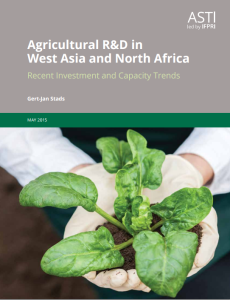The following post by Gert-Jan Stads, Senior Program Manager, Agricultural Science and Technology Indicators (ASTI), was originally published on ASTI News and Notes.
Over the past five decades, investments in agricultural R&D have had a tremendous impact on agricultural productivity and food security around the world. There is, however, a substantial time lag between investing in research and reaping its rewards: typically decades, not just years. Mobilizing adequate levels of long-term R&D funding is challenging, as agricultural R&D competes with other critical public domains, including health and education. Throughout the Arab world, agricultural R&D was not a political priority for decades, but when food prices rose to record highs in 2008, governments realized they could no longer neglect agricultural investment, and started looking at ways to enhance agricultural productivity.
To accelerate this agricultural growth, Arab countries need sustainable funding for strategic agricultural research programs, combined with well-trained researchers and well-equipped research centers. A recent report released by ASTI assesses trends in investments and human resource capacity in agricultural R&D in 11 countries in West Asia and North Africa during 2009–2012. It demonstrates that despite recent increases in agricultural R&D expenditures, spending in most countries still remains below the levels required to sustain their agricultural sectors’ needs. In most Arab countries, total agricultural R&D spending as a percentage of agricultural GDP continues to fall short of the United Nations guideline level of at least 1 percent.
On a positive note, considerable progress was made in building human capacity in agricultural R&D in West Asia and North Africa in recent years. Ten out of eleven countries for which detailed data were available reported increases in the number of PhD-qualified researchers. Egypt currently employs more agricultural researchers with PhDs than the rest of Africa combined. Another reason for the growth in capacity in recent years has been the higher education sector’s increased involvement in agricultural R&D, both due to the creation of new universities and of new departments and faculties within existing universities.Compared with other developing regions around the world, funding for agricultural R&D in Arab countries is very undiversified and relies largely on government sources. In many countries, government funding covers little more than salary-related expenses, leaving insufficient resources to facilitate day-to-day research operations, let alone the maintenance of infrastructure and equipment. Private funding remains a largely untapped resource. Cultivating private funding requires that Arab governments provide a more enabling policy environment through tax incentives, protection of intellectual property rights, and regulatory reforms to encourage the spill-in of international technologies.
Despite these advancements, retaining a critical mass of PhD-qualified researchers proves challenging. Official status differences between government and university-based scientists prevent government agencies in many countries from offering the competitive salaries and benefits. Many well-qualified, young researchers have left government R&D agencies in favor of better conditions at universities. Cross-country differences are also driving staff turnover. In recent years, there has been a considerable exodus of highly qualified professors and researchers from Egypt, Jordan, and Lebanon toward the Gulf and other high-income countries. Besides, more than half the PhD-qualified researchers at national agricultural research institutes in Algeria, Jordan, Tunisia, Sudan, and Yemen are over 50 and due to retire in the short- to medium-term. Adequate recruitment, succession, and training strategies are urgently called for to ensure future continuity of research in these countries.
Another critical area needing attention is the development of strong, national agricultural research policy agendas. In many Arab countries, agriculture-related priorities are not always satisfactorily embedded within national S&T policies, with the result that decisionmaking is fragmented and coordination among the relevant actors lacking. Policymakers must also ensure that improved varieties and technologies released by research institutes are more effectively disseminated to farmers. This involves strengthening agricultural extension agencies.
The impact of agricultural R&D does not stop at national borders. Given the numerous common challenges faced by Arab countries—including climate change, water scarcity, and rapid population growth—a more integrated approach to agricultural R&D that reduces wasteful duplication could benefit the region as a whole.







